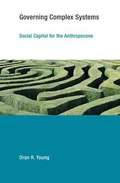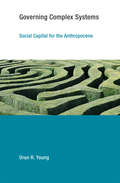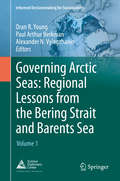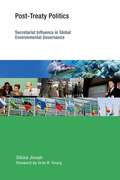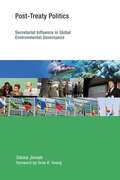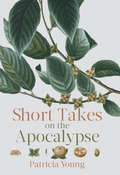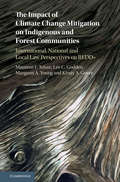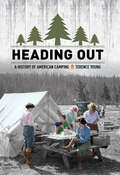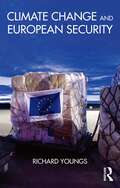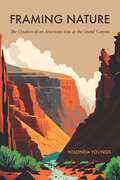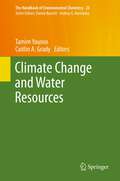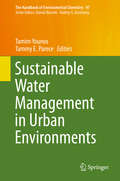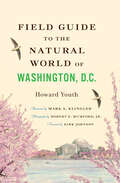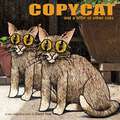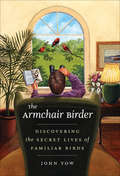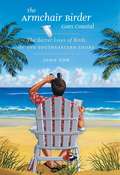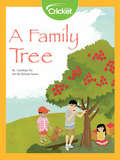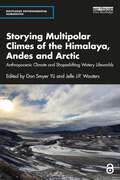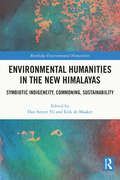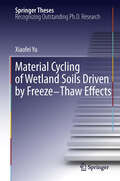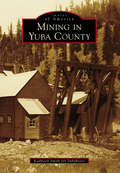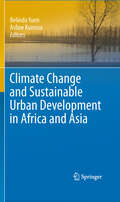- Table View
- List View
Governing Complex Systems: Social Capital for the Anthropocene
by Oran R. YoungThe onset of the Anthropocene, an era in which human actions have become major drivers of change on a planetary scale, has increased the complexity of socioecological systems. Complex systems pose novel challenges for governance because of their high levels of connectivity, nonlinear dynamics, directional patterns of change, and emergent properties. Meeting these challenges will require the development of new intellectual capital. In this book, Oran Young argues that to achieve sustainable outcomes in a world of complex systems, we will need governance systems that are simultaneously durable enough to be effective in guiding behavior and agile enough to adapt to rapidly changing circumstances. While some insights from past research on governance remain valid in this setting, Young argues that we need new social capital to supplement mainstream regulatory approaches that feature rule making with an emphasis on compliance and enforcement. He explores the uses of goal setting as a governance strategy, the idea of principled governance, and the role of what is often called good governance in meeting the challenges of the Anthropocene. Drawing on his long experience operating on the science/policy frontier, Young calls for more effective collaboration between analysts and practitioners in creating and implementing governance systems capable of producing sustainable outcomes in a world of complex systems.
Governing Complex Systems: Social Capital for the Anthropocene (Earth System Governance)
by Oran R. YoungAn exploration of the need for innovative mechanisms of governance in an era when human actions are major drivers of environmental change.The onset of the Anthropocene, an era in which human actions have become major drivers of change on a planetary scale, has increased the complexity of socioecological systems. Complex systems pose novel challenges for governance because of their high levels of connectivity, nonlinear dynamics, directional patterns of change, and emergent properties. Meeting these challenges will require the development of new intellectual capital. In this book, Oran Young argues that to achieve sustainable outcomes in a world of complex systems, we will need governance systems that are simultaneously durable enough to be effective in guiding behavior and agile enough to adapt to rapidly changing circumstances. While some insights from past research on governance remain valid in this setting, Young argues that we need new social capital to supplement mainstream regulatory approaches that feature rule making with an emphasis on compliance and enforcement. He explores the uses of goal setting as a governance strategy, the idea of principled governance, and the role of what is often called good governance in meeting the challenges of the Anthropocene. Drawing on his long experience operating on the science/policy frontier, Young calls for more effective collaboration between analysts and practitioners in creating and implementing governance systems capable of producing sustainable outcomes in a world of complex systems.
Governing Arctic Seas: Volume 1 (Informed Decisionmaking for Sustainability)
by Oran R. Young Paul Arthur Berkman Alexander N. VylegzhaninGoverning Arctic Seas introduces the concept of ecopolitical regions, using in-depth analyses of the Bering Strait and Barents Sea Regions to demonstrate how integrating the natural sciences, social sciences and Indigenous knowledge can reveal patterns, trends and processes as the basis for informed decisionmaking. This book draws on international, interdisciplinary and inclusive (holistic) perspectives to analyze governance mechanisms, built infrastructure and their coupling to achieve sustainability in biophysical regions subject to shared authority. Governing Arctic Seas is the first volume in a series of books on Informed Decisionmaking for Sustainability that apply, train and refine science diplomacy to address transboundary issues at scales ranging from local to global. For nations and peoples as well as those dealing with global concerns, this holistic process operates across a ‘continuum of urgencies’ from security time scales (mitigating risks of political, economic and cultural instabilities that are immediate) to sustainability time scales (balancing economic prosperity, environmental protection and societal well-being across generations). Informed decisionmaking is the apex goal, starting with questions that generate data as stages of research, integrating decisionmaking institutions to employ evidence to reveal options (without advocacy) that contribute to informed decisions. The first volumes in the series focus on the Arctic, revealing legal, economic, environmental and societal lessons with accelerating knowledge co-production to achieve progress with sustainability in this globally-relevant region that is undergoing an environmental state change in the sea and on land. Across all volumes, there is triangulation to integrate research, education and leadership as well as science, technology and innovation to elaborate the theory, methods and skills of informed decisionmaking to build common interests for the benefit of all on Earth.
Post-Treaty Politics
by Oran R. Young Sikina JinnahSecretariats -- the administrative arms of international treaties -- -would seem simply to do the bidding of member states. And yet, Sikina Jinnah argues in Post-Treaty Politics, secretariats can play an important role in world politics. On paper, secretariats collect information, communicate with state actors, and coordinate diplomatic activity. In practice, they do much more. As Jinnah shows, they can influence the allocation of resources, structures of interstate cooperation, and the power relationships between states.Jinnah examines secretariat influence through the lens of overlap management in environmental governance -- how secretariats help to manage the dense interplay of issues, rules, and norms between international treaty regimes. Through four case studies, she shows that secretariats can draw on their unique networks and expertise to handle the challenges of overlap management, emerging as political actors in their own right. After presenting a theory and analytical framework for analyzing secretariat influence, Jinnah examines secretariat influence on overlap management within the Convention on Biological Diversity (CBD), two cases of overlap management in the World Trade Organization, as well as a case in which the Convention on International Trade in Endangered Species (CITES) secretariat failed to influence political outcomes despite its efforts to manage overlap. Jinnah argues that, even when modest, secretariat influence matters because it can establish a path-dependent dynamic that continues to guide state behavior even after secretariat influence has waned.
Post-Treaty Politics
by Oran R. Young Sikina JinnahSecretariats -- the administrative arms of international treaties -- -would seem simply to do the bidding of member states. And yet, Sikina Jinnah argues in Post-Treaty Politics, secretariats can play an important role in world politics. On paper, secretariats collect information, communicate with state actors, and coordinate diplomatic activity. In practice, they do much more. As Jinnah shows, they can influence the allocation of resources, structures of interstate cooperation, and the power relationships between states.Jinnah examines secretariat influence through the lens of overlap management in environmental governance -- how secretariats help to manage the dense interplay of issues, rules, and norms between international treaty regimes. Through four case studies, she shows that secretariats can draw on their unique networks and expertise to handle the challenges of overlap management, emerging as political actors in their own right. After presenting a theory and analytical framework for analyzing secretariat influence, Jinnah examines secretariat influence on overlap management within the Convention on Biological Diversity (CBD), two cases of overlap management in the World Trade Organization, as well as a case in which the Convention on International Trade in Endangered Species (CITES) secretariat failed to influence political outcomes despite its efforts to manage overlap. Jinnah argues that, even when modest, secretariat influence matters because it can establish a path-dependent dynamic that continues to guide state behavior even after secretariat influence has waned.
Short Takes on the Apocalypse
by Patricia YoungThe poems in this collection originated as a response to Elmore Leonard's "Ten Rules of Writing" and metamorphosed into poetic responses to quotations and epigraphs on a variety of subjects.
The Impact of Climate Change Mitigation on Indigenous and Forest Communities: International, National and Local Law Perspectives on REDD+
by Young Tehan Maureen F Godden Lee C Margaret A Gover Kirsty AThe international legal framework for valuing the carbon stored in forests, known as 'Reducing Emissions from Deforestation and Forest Degradation' (REDD+), will have a major impact on indigenous peoples and forest communities. The REDD+ regime contains many assumptions about the identity, tenure and rights of indigenous and local communities who inhabit, use or claim rights to forested lands. The authors bring together expert analysis of public international law, climate change treaties, property law, human rights and indigenous customary land tenure to provide a systemic account of the laws governing forest carbon sequestration and their interaction. Their work covers recent developments in climate change law, including the Agreement from the Conference of the Parties in Paris that came into force in 2016. The Impact of Climate Change Mitigation on Indigenous and Forest Communities is a rich and much-needed new contribution to contemporary understanding of this topic.
Heading Out: A History of American Camping (American Institutions And Society Ser.)
by Terence YoungWho are the real campers? Through-hiking backpackers traversing the Appalachian Trail? The family in an SUV making a tour of national parks and sleeping in tents at campgrounds? People committed to the RV lifestyle who move their homes from state to state as season and whim dictate? Terence Young would say: all of the above. Camping is one of the country's most popular pastimes—tens of millions of Americans go camping every year. Whether on foot, on horseback, or in RVs, campers have been enjoying themselves for well more than a century, during which time camping’s appeal has shifted and evolved. In Heading Out, Young takes readers into nature and explores with them the history of camping in the United States.Young shows how camping progressed from an impulse among city-dwellers to seek temporary retreat from their exhausting everyday surroundings to a form of recreation so popular that an industry grew up around it to provide an endless supply of ever-lighter and more convenient gear. Young humanizes camping’s history by spotlighting key figures in its development and a sampling of the campers and the variety of their excursions. Readers will meet William H. H. Murray, who launched a craze for camping in 1869; Mary Bedell, who car camped around America for 12,000 miles in 1922; William Trent Jr., who struggled to end racial segregation in national park campgrounds before World War II; and Carolyn Patterson, who worked with the U.S. Department of State in the 1960s and 1970s to introduce foreign service personnel to the "real" America through trailer camping. These and many additional characters give readers a reason to don a headlamp, pull up a chair beside the campfire, and discover the invigorating and refreshing history of sleeping under the stars.
Climate Change and European Security (Routledge Advances in European Politics)
by Richard YoungsIt is now commonly asserted that climate change will fundamentally change international relations. It has been predicted that global warming will increase conflict within and between states, intensify food insecurity, menace the global trading system and unleash waves of migration. As a result governments are beginning to incorporate these warnings into their foreign policy initiatives. The appropriateness of their incipient responses needs to be examined in finer detail. This book looks at the impact of climate change on European Union (EU) security policy. It explores how governments are reconfiguring their geo-strategy and broader international relations in the wake of climate change warnings. The book demonstrates that although many aspects of EU foreign policies have begun to change, ‘climate security’ is not yet accorded unequivocal or sufficient priority. In doing so, Youngs argues that if climate change policies are to have significant effect they can no longer be treated as a separate area of policy but must be incorporated into the more mainstream debates pertinent to EU common foreign and security policy (CFSP). This book will be of key interest to students, scholars and practitioners of climate change and policy, energy and environmental policy, EU governance and foreign policy, European studies, international relations, geography, security studies/policy and environmental economics.
Framing Nature: The Creation of an American Icon at the Grand Canyon (America’s Public Lands)
by Yolonda YoungsThe Grand Canyon of the Colorado River is an internationally known feature of the North American landscape, attracting more than five million visitors each year. A deep cultural, visual, and social history has shaped the Grand Canyon&’s environment into one of America&’s most significant representations of nature. Yet the canyon is more than a vacation destination, a movie backdrop, or a scenic viewpoint; it is a real place as well as an abstraction easily summoned in the minds of Americans. The Grand Canyon, or the idea of it, is woven into the fabric of American cultural identity and serves as a cultural reference point—an icon. In Framing Nature Yolonda Youngs traces the idea of the Grand Canyon as an icon and the ways people came to know it through popular imagery and visual media. She analyzes and interprets more than fourteen hundred visual artifacts, including postcards, maps, magazine illustrations, and photographs of the Grand Canyon, supplemented with the words and ideas of writers, artists, explorers, and other media makers from 1869 to 2022. Youngs considers the manipulation and commodification of visual representations and shifting ideas, values, and meanings of nature, exploring the interplay between humans and their environments and how visual representations shape popular ideas and meanings about national parks and the American West. Framing Nature provides a novel interpretation of how places, especially national parks, are transformed into national and environmental symbols.
Climate Change and Water Resources (The Handbook of Environmental Chemistry #25)
by Tamim Younos Caitlin A. GradyThis volume presents nine chapters prepared by international authors and highlighting various aspects of climate change and water resources. Climate change models and scenarios, particularly those related to precipitation projection, are discussed and uncertainties and data deficiencies that affect the reliability of predictions are identified. The potential impacts of climate change on water resources (including quality) and on crop production are analyzed and adaptation strategies for crop production are offered. Furthermore, case studies of climate change mitigation strategies, such as the reduction of water use and conservation measures in urban environments, are included. This book will serve as a valuable reference work for researchers and students in water and environmental sciences, as well as for governmental agencies and policy makers.
Sustainable Water Management in Urban Environments
by Tamim Younos Tammy E. PareceThisvolume focuses on practical aspects of sustainable water management in urbanareas and presents a discussion of key concepts, methodologies, and casestudies of innovative and evolving technologies. Topics include: (1) challengesin urban water resiliency; (2) water and energy nexus; (3) integrated urbanwater management; and (4) water reuse options (black water, gray water,rainwater). This volume serves as a useful reference for students andresearchers involved in holistic approaches to water management, and as avaluable guide to experts in governmental agencies as well as planners andengineers concerned with sustainable water management systems in urbanenvironments.
Field Guide to the Natural World of Washington, D.C.
by Howard YouthA field guide to plants and animals commonly found in the nation's capital.Winner of the Design and Effectiveness Award of the Washington PublishersNature awaits discovery at almost every turn in the complex ecosystem of Washington, D.C. In parks large and small, within the District's gardens, and on public streets, there is tremendous biodiversity. In Field Guide to the Natural World of Washington, D.C., naturalist Howard Youth takes us on an urban safari, describing the wild side of the nation's capital.Beyond the abundant wildlife that can be seen in every neighborhood, Washington boasts a large park network rich in natural wonders. A hike along the trails of Rock Creek Park, one of the country’s largest and oldest urban forests, quickly reveals white-tailed deer, eastern gray squirrels, and little brown bats. Mayapples, Virginia bluebells, and red mulberry trees are but a few of the treasures found growing at the National Arboretum. A stroll along the Potomac and Anacostia Rivers might reveal stealthy denizens such as bullfrogs, largemouth bass, and common snapping turtles. Detailed drawings by Carnegie artist Mark A. Klingler and photography by Robert E. Mumford, Jr., reveal the rich color and stunning beauty of the flora and fauna awaiting every D.C. naturalist.Whether seeking a secluded jog or an adventurous outing, residents and tourists alike will find this handsome guide indispensable for finding oases away from the noise of the city.
Field Guide to the Natural World of Washington D.C.
by Howard YouthDiscover the wonders of Washington’s complex ecosystem with this field guide to the district’s parks, gardens, urban forests and more.Every neighborhood of Washington, D.C., is home to abundant wildlife, and its large park network is rich in natural wonders. A hike along the trails of Rock Creek Park, one of the country’s largest and oldest urban forests, quickly reveals white-tailed deer, eastern gray squirrels, and little brown bats. Mayapples, Virginia bluebells, and red mulberry trees are but a few of the treasures found growing at the National Arboretum. A stroll along the Potomac and Anacostia Rivers might reveal stealthy denizens such as bullfrogs, largemouth bass, and common snapping turtles. In Field Guide to the Natural World of Washington, D.C., naturalist Howard Youth takes readers on an urban safari, describing the wild side of the nation’s capital. Detailed drawings by Carnegie artist Mark A. Klingler and photography by Robert E. Mumford, Jr., reveal the stunning color and beauty of the flora and fauna awaiting every D.C. naturalist.Residents and tourists alike will find this guide indispensable, whether seeking a secluded jog or an adventurous outing away from the noise of the city.
Copycat: and a Litter of Other Cats
by David Yow"Each page is delightful. These are premium cat drawings, quite worthy of this handsome hardcover book."--Newcity Lit"David Yow is part punk, part cat lady."--Brooklyn Paper"Fortunately, if you’ve been looking for a less embarrassing thing than Cat Fancy to adorn your coffee table, I’ve got good news: David Yow has just the book for you."--Verbicide Magazine"You could say Yow's book is the cat's MeYow. Snap it up fast cat peeps."--Cat Wisdom 101"Something good to read with your kids."--The Big Takeover"Surely you know crazy cat people like me who could use a hardback kitty-art book. Indulge them. They'll thank you--after they're done giggling--I'm sure of it."--Persephone Magazine"Feeling down? Leafing through this book is sure to make you smile! It is the purrfect gift for cat lovers of all ages and one you will want to turn the pages of again and again! It's also purrfect cocktail party fodder, keep this just a paw's reach away on your coffee-table, you have an instant conversation starter!"--Cat Chat with Caren and Cody"Cats and puns illustrated by a musician? It's like the Book Gods sensed a need in my life and amply provided."--The Cannonball Read"The only thing I did not like about Copycat is that, according to my human, kitties are not supposed to eat it."--Sparkle the Designer Cat"Cute drawings mixed with photos, very creatively crafted, with an endearing little face on each one."--Cottage Country Reflections"This is a great collection...an interesting and eye catching coffee table book."--Jenn's Review Blog"If you're a fan of graphics, words, or cats, this book will talk to you....I don't think you'll find another one like this unique book."--Journey of a Bookseller"This is a charming collection of drawings by David Yow...The drawings are all beautiful and David Yow's talent shines in each one."--Socrates' Book Reviews, "5-kitten" review"Copycat is a fun and whimsical book that any cat lover will enjoy."--Bergers Book Reviews"Hey David, it's me BUB. I read your book, and can't deny that I didn't read the whole thing in the first sitting. 'Catsup' and 'Catastrophe' are worth the price of admission alone. WOW YOW, MEOW."--Lil BUB, Internet cat celebrityDavid Yow's cat portraits, captured here for the first time in book form, are bold, striking, hilarious, and beautiful. Each portrait is based around a pun, but they capture so much more than wordplay. All cat lovers will find something to relish in this gorgeous coffee-table book, which is the perfect gift for cat enthusiasts, animal lovers, and anyone with a playful sense of humor.About the book, David Yow says: "I love cats. Always have. The only time I didn't have a cat was a brief hell in Chicago where I lived in an apartment whose landlord didn't allow them. At that place, I had a life-sized cardboard cutout of a cat which I named Toody. I also love wordplay. I'm the only adult I hang out with who still gets a kick out of puns. I make up palindromes. I used to write songs and poems (these days, I leave that for the songwriters and poets); in this book of cat-pun drawings, I have made a concerted effort to come up with ideas that range from really funny to really amusing. The entire litter of animals in this book are line drawings that are 'colored in' with photographic textures, and each cat is dropped into a photographic setting. Yep, that's the truth."
The Armchair Birder: Discovering the Secret Lives of Familiar Birds
by John YowBird lovers, take heart! While the birding literature is filled with tales of expert observers spotting rare species in exotic locales, John Yow's The Armchair Birder reminds us that the most fascinating birds can be the ones perched right outside our windows. In thirty-five engaging, humorous, and even irreverent essays, Yow reveals the fascinating lives of birds you probably already recognize and naturally want to know more about--because they're the ones you see nearly every day. Following the seasons of the year, Yow covers forty-two species, from the Carolina wren that rings in the springtime to the sandhill crane croaking high overhead at the end of winter. Leisurely and entertaining, the essays explore the improbable, unusual, and comical aspects of their subjects' lives--from the philandering of the ruby-throated hummingbird to the occasional dipsomania of the cedar waxwing. Rather than bare facts and field marks, The Armchair Birder offers observations, anecdotes, and stories--not only Yow's own, but also those of America's classic bird writers, such as John James Audubon, Arthur Bent, and Edward Forbush, experts who saw it all and wrote with wit and passion. With The Armchair Birder, backyard birders will take new delight in the birds at their feeders, while veteran check-listers will enjoy putting their feet up. All will applaud this unique addition to bird literature, one that combines the fascination of bird life with the pleasure of good reading.
The Armchair Birder Goes Coastal
by John YowWith his distinctively witty, anecdotal, and disarming voice, John Yow now journeys to the shore and shares his encounters with some of the most familiar and beloved coastal birds. Out of his travels--from North Carolina's Outer Banks, down the Atlantic coast, and westward along the Gulf of Mexico--come colorful accounts of twenty-eight species, from ubiquitous beach birds like sanderlings and laughing gulls to wonders of nature like roseate spoonbills and the American avocets. Along the way, Yow delves deeply into the birds' habits and behaviors, experiencing and relating the fascination that leads many an amateur naturalist to become the most unusual of species--a birder.Seasonally organized chapters explore the improbable, the wonderful, and the amusing aspects of these birds' lives. Yow embellishes his observations with field notes, anecdotes, and stories from some of America's finest naturalists--including John James Audubon, Arthur Cleveland Bent, Rachel Carson, and Peter Matthiessen. Combining the endless fascination of bird life with the pleasure of good reading, The Armchair Birder Goes Coastal is the perfect companion for any nature lover's next trip to the beach.
The Armchair Birder's Omnibus Ebook
by John YowAvailable for the first time together in this Omnibus E-Book, The Armchair Birder's Omnibus brings together both of John Yow's delightful books into one convenient e-book.While birding literature is filled with tales of expert observers spotting rare species in exotic locales, John Yow reminds us in The Armchair Birder, that the most fascinating birds can be the ones perched right outside our windows. In thirty-five engaging and sometimes irreverent vignettes, Yow reveals the fascinating lives of the birds we see nearly every day. Following the seasons, he covers forty-two species, discussing the improbable, unusual, and comical aspects of his subjects' lives. Yow offers his own observations, anecdotes, and stories as well as those of America's classic bird writers, such as John James Audubon, Arthur Bent, and Edward Forbush. This unique addition to bird literature combines the fascination of bird life with the pleasure of good reading.In his follow-up volume The Armchair Birder Goes Coastal, Yow now journeys to the shore and shares his encounters with some of the most familiar and beloved coastal birds. Out of his travels--from North Carolina's Outer Banks, down the Atlantic coast, and westward along the Gulf of Mexico--come colorful accounts of twenty-eight species, from ubiquitous beach birds like sanderlings and laughing gulls to wonders of nature like roseate spoonbills and the American avocets. Along the way, Yow delves deeply into the birds' habits and behaviors, experiencing and relating the fascination that leads many an amateur naturalist to become the most unusual of species--a birder.
A Family Tree
by Caroline YuHannah's grandmother has a tree growing in the front yard that produces a delicious, sweet fruit. The tree is very special to Hannah's family.
Storying Multipolar Climes of the Himalaya, Andes and Arctic: Anthropocenic Climate and Shapeshifting Watery Lifeworlds (Routledge Environmental Humanities)
by Dan Smyer Yü Jelle J.P. WoutersThis book initiates multipolar climate/clime studies of the world’s altitudinal and latitudinal highlands with terrestrial, experiential, and affective approaches. Framed in the environmental humanities, it is an interdisciplinary, comparative study of the mutually-embodied relations of climate, nature, culture, and place in the Himalaya, Andes, and Arctic. Innovation-driven, the book offers multipolar clime case studies through the contributors’ historical findings, ethnographic documentations, and diverse conceptualizations and applications of clime, an overlooked but returning notion of place embodied with climate history, pattern, and changes. The multipolar clime case studies in the book are geared toward deeper, lively explorations and demonstrations of the translatability, interchangeability, and complementarity between the notions of clime and climate. "Multipolar" or "multipolarity" in this book connotes not only the two polar regions and the tectonically shaped highlands of the earth but also diversely debated perspectives of climate studies in the broadest sense. Contributors across the twelve chapters come from diverse fields of social and natural sciences and humanities, and geographically specialize, respectively, in the Himalayan, Andean, and Arctic regions. The first comparative study of climate change in altitudinal and latitudinal highlands, this will be an important read for students, academics, and researchers in environmental humanities, anthropology, climate science, indigenous studies, and ecology. Chapters 8 and 9 of this book are freely available as a downloadable Open Access PDF at http://www.taylorfrancis.com/books/e/10.4324/9781003347026 under a Creative Commons Attribution-Non Commercial-No Derivatives (CC-BY-NC-ND) 4.0 license.
Environmental Humanities in the New Himalayas: Symbiotic Indigeneity, Commoning, Sustainability (Routledge Environmental Humanities)
by Dan Smyer Yü Erik De MaakerEnvironmental Humanities in the New Himalayas: Symbiotic Indigeneity, Commoning, Sustainability showcases how the eco-geological creativity of the earth is integrally woven into the landforms, cultures, and cosmovisions of modern Himalayan communities. Unique in scope, this book features case studies from Bhutan, Assam, Sikkim, Tibet, Nepal, Pakistan, and Sino-Indian borderlands, many of which are documented by authors from indigenous Himalayan communities. It explores three environmental characteristics of modern Himalayas: the anthropogenic, the indigenous, and the animist. Focusing on the sentient relations of human-, animal-, and spirit-worlds with the earth in different parts of the Himalayas, the authors present the complex meanings of indigeneity, commoning and sustainability in the Anthropocene. In doing so, they show the vital role that indigenous stories and perspectives play in building new regional and planetary environmental ethics for a sustainable future. Drawing on a wide range of expert contributions from the natural sciences, social sciences, and humanist disciplines, this book will be of great interest to students and scholars of environmental humanities, religion and ecology, indigenous knowledge and sustainable development more broadly.
Four Weeks, Five People
by Jennifer YuThey're more than their problems Obsessive-compulsive teen Clarissa wants to get better, if only so her mother will stop asking her if she's okay. Andrew wants to overcome his eating disorder so he can get back to his band and their dreams of becoming famous. Film aficionado Ben would rather live in the movies than in reality. Gorgeous and overly confident Mason thinks everyone is an idiot. And Stella just doesn't want to be back for her second summer of wilderness therapy. As the five teens get to know one another and work to overcome the various disorders that have affected their lives, they find themselves forming bonds they never thought they would, discovering new truths about themselves and actually looking forward to the future.
Material Cycling of Wetland Soils Driven by Freeze-Thaw Effects
by Xiaofei YuFreezing and thawing of soils is a common phenomenon in the winter-cold zone. The thesis titled "Material Cycling of Wetland Soils Driven by Freeze-Thaw Effects" systematically explores the freeze-thaw effects on the accumulation and release processes of carbon and nitrogen in wetland soils, which is a good step toward the investigation of biogeochemical processes in wetlands in seasonal freeze-thaw areas. It is also developing strategies aimed at global warming effects on the accumulation and release of carbon and nitrogen in wetlands. Dr. Xiaofei Yu works at the Northeast Institute of Geography and Agroecology, Chinese Academy of Sciences, China.
Mining in Yuba County
by Yubaroots Kathleen SmithMining in Yuba County illustrates the story of how this geologically unique part of California drew multitudes of people from around the world during the early days of the Gold Rush. It depicts the region's evolution from anarchy to civilization. It gives faces to the individuals who were instrumental in creating society in Yuba. It elaborates on incidents in which Yuba influenced the nation, on matters as historically significant as California entering the Union as a free state and affecting the outcome of the Civil War. Mining in Yuba fostered technological advancement precipitated by the depletion of surface gold and the necessity to get to the obscured gold. Conflicts between miners and agriculturists over hydraulic mining were litigated, and landmark legal decisions regarding the regulation of hydraulic mining all but ended the practice and were the beginnings of environmental protectionism and water rights issues in California. Finally, it reveals that despite heavy regulations that exist today, there is still mining in Yuba County.
Climate Change and Sustainable Urban Development in Africa and Asia
by Belinda Yuen Asfaw KumssaThis book is about African and Asian cities. Illustrated through selected case cities, the book brings together a rich collection of papers by leading scholars and practitioners in Africa and Asia to offer empirical analysis and up-to-date discussions and assessments of the urban challenges and solutions for their cities. A number of key topics concerning housing, sustainable urban development and climate change in Africa and Asia are explored along with how policy interventions and partnerships deliver specific forms of urban development. It is intended for all who are interested in the state of the cities and urban development in Africa and Asia. Africa and Asia present, in many ways, useful lessons in dealing with the burgeoning urban population, and the problems surrounding this influx of people and climate change in the developing word.
